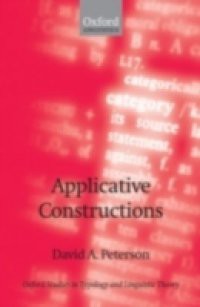This book presents the first systematic typological analysis of applicatives across African, American Indian, and East Asian languages. It is also the first to address their functions in discourse, the derivation of their semantic and syntactic properties, and how and why they have changed over time. Applicative constructions are typically described as transitivizing because they allow an intransitive base verb to have a direct object. The term originates from the seventeenth-century missionary grammars of Uto-Aztecan languages. Constructions designated as prepositional, benefactive, and instrumental may refer to the same or similar phenomena. Applicative constructions have been deployed in the development of a range of syntactic theories which have then often been used to explain theirfunctions, usually within the context of Bantu languages. Dr Peterson provides a wealth of cross-linguistic information on discourse-functional, diachronic, and typological aspects of applicative constructions. He documents their unexpected synchronic variety and the diversity of diachronic sourcesabout them. He argues that many standard assumptions about applicatives are unfounded, and provides a clear guide for future language-specific and cross-linguistic research and analysis.

